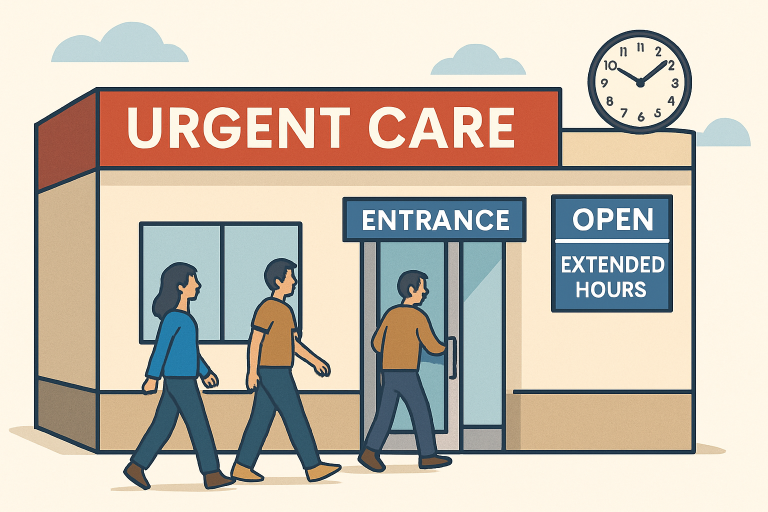The benefits of walk-in urgent care clinics
Key takeaways
- Walk-in urgent care clinics provide fast, convenient care for non-emergency health issues.
- Extended hours and accessible locations make care easier for busy individuals and families.
- Clinics handle minor injuries, infections, and common illnesses, complementing primary care.
- Lower costs and shorter wait times improve patient satisfaction and reduce financial burden.
- Urgent care supports community health by easing ER demand and coordinating follow-up care.
What sets walk-in urgent care clinics apart?
Accessing timely health care can be a challenge for many individuals and families. Traditional primary care offices often require appointments booked days in advance, while emergency rooms can entail hours-long waits and costly bills for non-life-threatening issues.
In response, walk in urgent care center Linden offers immediate and convenient solutions for a variety of non-emergency health concerns. These clinics provide care on a walk-in basis, eliminating the need for appointments and significantly reducing wait times compared to hospital emergency departments.
Convenience is at the heart of the urgent care model. Most walk-in clinics are located in accessible neighborhoods and commercial areas, making them easy to reach at home, work, or school. With growing demand for quick, reliable care, urgent care clinics have become a preferred alternative for those needing prompt medical attention without the long waits or the logistical challenges of traditional healthcare routes.
Key benefits for busy individuals and families
One primary advantage of urgent care clinics is their extended operating hours, often including evenings and weekends when other healthcare providers are closed. This flexibility makes it easier for working adults, busy parents, and students to address their health needs without rearranging their schedules or missing important commitments. Whether it’s a sudden fever on a Saturday night or a minor injury after school, urgent care clinics deliver fast solutions without the hassle of scheduling far in advance.
Beyond flexibility, these clinics provide quick access to care for common ailments such as minor injuries, illnesses, and infections. The result is a healthcare option that supports the demands of modern life, ensuring that families and individuals can get the care they need, when they need it most.
Caring for common health issues
Urgent care clinics are well-equipped to handle a broad range of medical issues. They regularly treat respiratory infections, sprains, minor lacerations, burns, and similar concerns that do not warrant an emergency room visit. Additionally, urgent care centers can manage seasonal allergies, care for minor fractures, and even address mild asthma attacks.

These services complement primary care by offering after-hours support and fill the gap between routine family doctor visits and emergency rooms. By addressing common but urgent issues, clinics help keep patients healthy and out of crowded ERs, which are best reserved for severe or life-threatening emergencies.
Cost comparison: Walk-in urgent care vs. emergency rooms
For most non-critical conditions, urgent care costs significantly less than an emergency room visit. Transparent billing practices and lower fees help alleviate the financial burden on individuals, families, and the healthcare system. According to the Health Affairs journal, urgent care for non-emergent health issues can substantially reduce healthcare spending without compromising patient outcomes.
Faster service times and straightforward payment models also provide a more satisfying patient experience. This financial accessibility supports wider community health and reduces the likelihood of individuals delaying care due to cost concerns.
Wait times and patient satisfaction
National averages show that a provider often sees patients at urgent care clinics within 30 minutes, and the entire visit typically concludes in under an hour. This starkly contrasts with the much lengthier waits frequently encountered at hospital ERs. According to the Centers for Disease Control and Prevention, faster treatment correlates directly with higher patient trust and satisfaction, as patients are more likely to seek prompt care when they know they won’t face extensive delays.
Urgent care clinics have established a strong reputation for positive patient experiences and reliable medical solutions by prioritizing efficiency without sacrificing quality.
Supporting community health
Walk-in urgent care clinics play a critical role in supporting broader community health. By providing quick, accessible care for non-emergency issues, these facilities help reduce unnecessary strain on hospital emergency rooms, which must remain available for the most serious cases. Their presence fosters preventive care and encourages patients to seek early intervention for developing problems.
Many urgent care clinics also coordinate with local primary care providers, hospitals, and pharmacies to ensure continuity of treatment and follow-up when needed. This collaborative approach strengthens local healthcare networks, supporting healthier communities overall.
When to choose urgent care over the ER or doctor’s office
Understanding the Scope of Urgent Care
Urgent care clinics are ideal for treating non-life-threatening conditions such as minor fractures, sprains, infections, and mild allergic reactions. Patients should, however, recognize when symptoms are more serious—such as chest pain, severe shortness of breath, numbness, or symptoms of stroke—and seek emergency room services without delay in these cases.
Urgent care’s unique role is to bridge the gap between regular doctor’s visits and emergency care, ensuring patients are never left without support for sudden, but manageable, health issues.
Future trends in urgent care services
Urgent care is a rapidly evolving sector. Emerging technologies such as telemedicine, digital check-ins, and electronic health records are improving efficiency and patient experience. Integrated care solutions that blend urgent, primary, and specialty services are on the rise, aiming to deliver holistic care under one virtual or physical roof.
As healthcare policy and regulations continue to evolve, urgent care clinics will likely play an even greater role in the future. They will respond to changing patient needs and further expand the reach and quality of accessible healthcare.




